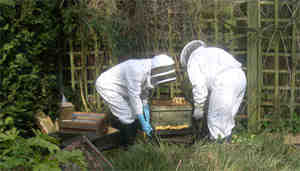Shaking the bees into the hive
Posted by Fiona Nevile in Bees | 2 comments
Working with the new beehive
Lindsay advised us that the best way of getting on top of the problem is to shake the queen and the workers from the recently acquired hive into our existing brood box. Then we should burn the old frames containing the infected brood and eggs.
Shaking the bees has three advantages:
- infected brood will die
- bees will think that they have swarmed and will work hard to quickly create a strong colony
- the bees will be unlikely to swarm again this season.
There is one big problem when lifting frames from one hive to shake into another. It’s very easy to lose the queen. In egg laying mode she becomes weighty and unable to fly. If she drops off a frame onto the ground it’s generally curtains as she cannot fly back into the hive. So Lindsay volunteered to help us as we are still inexperienced beekeepers.
We carefully searched for the queen through all 11 frames of the brood chamber. The bees looked pretty healthy, with none of the deformities that even I have noticed with a Varroa infestation.
Some of the frames looked so good that it seemed a shame to burn them. Lindsay used a drone fork to examine the drone brood. If Varroa mites were present they would be easy to spot. They show up as small elongated dots in the brood.
The brood was clean. Danny had a go too. Still clear. So Lindsay suggested that we kept the better frames and just replaced the older ones.
Despite the air being thick with bees, this was a surprisingly companionable and relaxed morning. All our questions were answered and we learnt loads.
So we have a strong colony of new bees that is not yet infested with ‘resistant mites’ or the standard Varroa mites. They will come and in the autumn we will treat them with the appropriate treatment. Things will have probably moved on by then and the DEFRA site wil ltell all.
We will know whether or not we have a queen in five days time, when we examine the brood frames for fresh eggs. If there are new eggs then the queen is still in residence. If not, the workers bees will spring into action. With a bit of guidance, the worker bees will make one new queen. This only takes 16 days. So it’s win/win at the moment. Thanks Lindsay and Chris (the guy who owned the bees). Enormously appreciated all round.
Wey hey! We are up and running again. We are enjoying the resonant hum from the hive and the foraging bees.
Leave a reply





You could probably keep bees on your allotment. Lots of people do in England.
This is so interesting. I just watched the episode of Beyond River Cottage where he gets his bees. Your post was much more informative. Thanks.